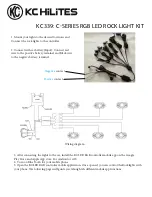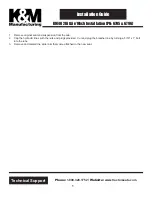
012-15878A
|
1
|
www.pasco.com - (800) 772-8700
Software: SPARKvue or PASCO Capstone
Power: Rechargeable Battery
Connection:
or
USB
PASCO Wireless Blood Pressure Sensor PS-3218
www.pasco.com - (800) 772-8700
Connection:
or USB
012-15878A
|
1
|
Software: SPARKvue or PASCO Capstone
Power: Rechargeable Battery
PASCO Wireless Blood Pressure Sensor PS-3218
INITIAL STEP -
Connect and charge it:
Use the micro USB cable
to connect the sensor to a USB port or a USB charger (such as PS-
3501). If the cable is connected to a USB
port
, the Battery status
LED shines yellow to show that the battery is charging. When the
battery is charged, the Battery status LED shines green. If the
cable is connected to a USB
charger
, the Battery status LED shines
yellow
and
the Bluetooth status LED blinks red to indicate that
the sensor is ready to connect to a device (such as a computer or
tablet).
1. Make the Connection:
Start the PASCO data collection software.
• For
USB connection to a USB port
: Make sure the USB cable is connected.
In
SPARKvue
,: Check that the sensor appears on the Home Screen. In
PASCO Capstone
, select ‘Hardware Setup” and check that the sensor
appears in the “Hardware Setup” window.
• For
Bluetooth connection
: If the sensor is not already on, press the ON button at the end of the sensor to turn it on. (NOTE: The following pro-
cedure also works if the sensor is connected to a USB
charger
.)
In
SPARKvue
: Select the Bluetooth icon. In the “Wireless Devices” list, select the correct address that matches the XXX-XXX number found
on the sensor. Select “Done”. In
PASCO Capstone
, select “Hardware Setup” in the “Tools” palette. Select the desired sensor type that
matches the Device ID XXX-XXX number on the sensor. Close the “Hardware Setup” window.
2. Collect Data:
In
SPARKvue,
select a measurement from the list. A graph of the measurement versus time opens. Select the “Start” button. In
PASCO Capstone:
Select a display, set up the temperature measurement in the display, and select “Record”.
NOTE: For Educational Use Only.
Th
is is not a medical device. It is designed for educational use only and should not be used in any medical
process such as life support or patient diagnosis. The sensor
is designed by PASCO in California.
Bluetooth LED
ON button
About 3
hours
Micro USB cable
Device ID
Battery LED
INITIAL STEP -
Connect and charge it:
Use the micro USB cable
to connect the sensor to a USB port or a USB charger (such as PS-
3501). If the cable is connected to a USB
port
, the Battery status
LED shines yellow to show that the battery is charging. When the
battery is charged, the Battery status LED shines green. If the
cable is connected to a USB
charger
, the Battery status LED shines
yellow
and
the Bluetooth status LED blinks red to indicate that
the sensor is ready to connect to a device (such as a computer or
tablet).
1. Make the Connection:
Start the PASCO data collection software.
• For
USB connection to a USB port
: Make sure the USB cable is connected.
In
SPARKvue
,: Check that the sensor appears on the Home Screen. In
PASCO Capstone
, select ‘Hardware Setup” and check that the sensor
appears in the “Hardware Setup” window.
• For
Bluetooth connection
: If the sensor is not already on, press the ON button at the end of the sensor to turn it on. (NOTE: The following pro-
cedure also works if the sensor is connected to a USB
charger
.)
In
SPARKvue
: Select the Bluetooth icon. In the “Wireless Devices” list, select the correct address that matches the XXX-XXX number found
on the sensor. Select “Done”. In
PASCO Capstone
, select “Hardware Setup” in the “Tools” palette. Select the desired sensor type that
matches the Device ID XXX-XXX number on the sensor. Close the “Hardware Setup” window.
2. Collect Data:
In
SPARKvue,
select a measurement from the list. A graph of the measurement versus time opens. Select the “Start” button. In
PASCO Capstone:
Select a display, set up the temperature measurement in the display, and select “Record”.
NOTE: For Educational Use Only.
Th
is is not a medical device. It is designed for educational use only and should not be used in any medical
process such as life support or patient diagnosis. The sensor
is designed by PASCO in California.
Bluetooth LED
ON button
About 3
hours
Micro USB cable
Device ID
Battery LED




















